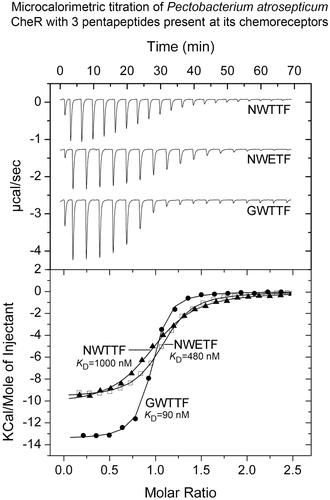当前位置:
X-MOL 学术
›
Mol. Microbiol.
›
论文详情
Our official English website, www.x-mol.net, welcomes your
feedback! (Note: you will need to create a separate account there.)
Differential CheR Affinity for Chemoreceptor C-Terminal Pentapeptides Modulates Chemotactic Responses
Molecular Microbiology ( IF 2.6 ) Pub Date : 2024-08-23 , DOI: 10.1111/mmi.15305 Félix Velando 1 , Elizabet Monteagudo-Cascales 1 , Miguel A Matilla 1 , Tino Krell 1
Molecular Microbiology ( IF 2.6 ) Pub Date : 2024-08-23 , DOI: 10.1111/mmi.15305 Félix Velando 1 , Elizabet Monteagudo-Cascales 1 , Miguel A Matilla 1 , Tino Krell 1
Affiliation

|
Many chemoreceptors contain a C-terminal pentapeptide at the end of a linker. In Escherichia coli, this pentapeptide forms a high-affinity binding site for CheR and phosphorylated CheB, and its removal interferes with chemoreceptor adaptation. Analysis of chemoreceptors revealed significant variation in their pentapeptide sequences, and bacteria often possess multiple chemoreceptors with differing pentapeptides. To assess whether this sequence variation alters CheR affinity and chemotaxis, we used Pectobacterium atrosepticum SCRI1043 as a model. SCRI1043 has 36 chemoreceptors, with 19 of them containing a C-terminal pentapeptide. We show that the affinity of CheR for the different pentapeptides varies up to 11-fold (KD 90 nM to 1 μM). Pentapeptides with the highest and lowest affinities differ only in a single amino acid. Deletion of the cheR gene abolishes chemotaxis. The replacement of the pentapeptide in the PacC chemoreceptor with those of the highest and lowest affinities significantly reduced chemotaxis to its cognate chemoeffector, L-Asp. Altering the PacC pentapeptide also reduced chemotaxis to L-Ser, but not to nitrate, which are responses mediated by the nontethered PacB and PacN chemoreceptors, respectively. Changes in the pentapeptide sequence thus modulate the response of the cognate receptor and that of another chemoreceptor.
中文翻译:

化学感受器 C 末端五肽的差异 CheR 亲和力调节趋化反应
许多化学感受器在接头末端包含一个 C 端五肽。在大肠杆菌中,这种五肽形成 CheR 和磷酸化 CheB 的高亲和力结合位点,其去除会干扰化学感受器的适应。化学感受器的分析揭示了其五肽序列的显着变化,并且细菌通常具有具有不同五肽的多个化学感受器。为了评估这种序列变异是否改变 CheR 亲和力和趋化性,我们使用 Pectobacterium atrosepticum SCRI1043 作为模型。SCRI1043 有 36 个化学感受器,其中 19 个含有 C 端五肽。我们表明 CheR 对不同五肽的亲和力变化高达 11 倍(KD90 nM 至 1 μM)。具有最高亲和力和最低亲和力的五肽仅在单个氨基酸中有所不同。cheR 基因的缺失会消除趋化性。用最高和最低亲和力的五肽替换 PacC 化学感受器中的五肽显着降低了对其同源化学效应子 L-Asp 的趋化性。改变 PacC 五肽还降低了对 L-Ser 的趋化性,但不降低了对硝酸盐的趋化性,硝酸盐分别是由非栓系的 PacB 和 PacN 化学感受器介导的反应。因此,五肽序列的变化调节同源受体和另一个化学感受器的反应。
更新日期:2024-08-23
中文翻译:

化学感受器 C 末端五肽的差异 CheR 亲和力调节趋化反应
许多化学感受器在接头末端包含一个 C 端五肽。在大肠杆菌中,这种五肽形成 CheR 和磷酸化 CheB 的高亲和力结合位点,其去除会干扰化学感受器的适应。化学感受器的分析揭示了其五肽序列的显着变化,并且细菌通常具有具有不同五肽的多个化学感受器。为了评估这种序列变异是否改变 CheR 亲和力和趋化性,我们使用 Pectobacterium atrosepticum SCRI1043 作为模型。SCRI1043 有 36 个化学感受器,其中 19 个含有 C 端五肽。我们表明 CheR 对不同五肽的亲和力变化高达 11 倍(KD90 nM 至 1 μM)。具有最高亲和力和最低亲和力的五肽仅在单个氨基酸中有所不同。cheR 基因的缺失会消除趋化性。用最高和最低亲和力的五肽替换 PacC 化学感受器中的五肽显着降低了对其同源化学效应子 L-Asp 的趋化性。改变 PacC 五肽还降低了对 L-Ser 的趋化性,但不降低了对硝酸盐的趋化性,硝酸盐分别是由非栓系的 PacB 和 PacN 化学感受器介导的反应。因此,五肽序列的变化调节同源受体和另一个化学感受器的反应。






























 京公网安备 11010802027423号
京公网安备 11010802027423号